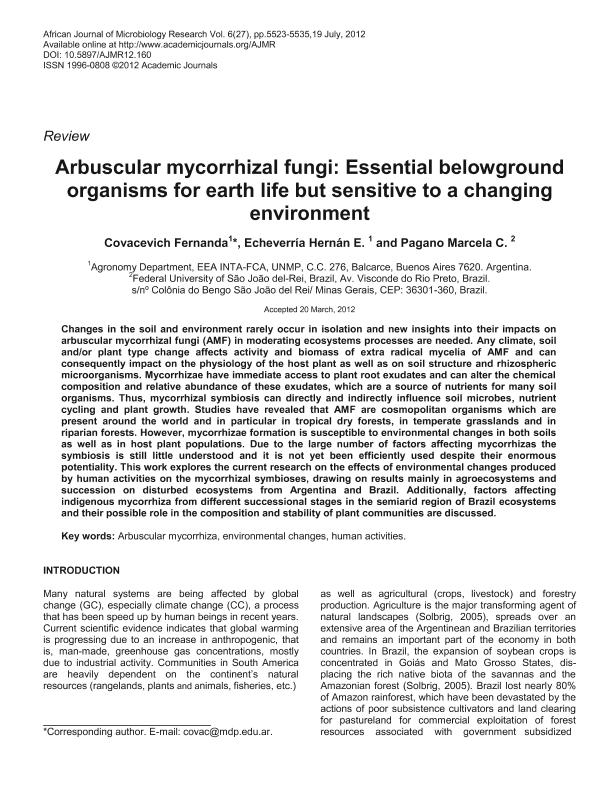Mostrar el registro sencillo del ítem
dc.contributor.author
Covacevich, Fernanda

dc.contributor.author
Echeverría, Hernán E.
dc.contributor.author
Pagano, Marcela Claudia

dc.date.available
2023-05-19T15:19:30Z
dc.date.issued
2012-07
dc.identifier.citation
Covacevich, Fernanda; Echeverría, Hernán E.; Pagano, Marcela Claudia; Arbuscular mycorrhizal fungi: Essential belowground organisms for earth life but sensitive to a changing environment; Academic Journals; African Journal Of Microbiology Research; 6; 27; 7-2012; 5523-5535
dc.identifier.issn
1996-0808
dc.identifier.uri
http://hdl.handle.net/11336/198149
dc.description.abstract
Changes in the soil and environment rarely occur in isolation and new insights into their impacts on arbuscular mycorrhizal fungi (AMF) in moderating ecosystems processes are needed. Any climate, soil and/or plant type change affects activity and biomass of extra radical mycelia of AMF and can consequently impact on the physiology of the host plant as well as on soil structure and rhizospheric microorganisms. Mycorrhizae have immediate access to plant root exudates and can alter the chemical composition and relative abundance of these exudates, which are a source of nutrients for many soil organisms. Thus, mycorrhizal symbiosis can directly and indirectly influence soil microbes, nutrient cycling and plant growth. Studies have revealed that AMF are cosmopolitan organisms which are present around the world and in particular in tropical dry forests, in temperate grasslands and in riparian forests. However, mycorrhizae formation is susceptible to environmental changes in both soils as well as in host plant populations. Due to the large number of factors affecting mycorrhizas the symbiosis is still little understood and it is not yet been efficiently used despite their enormous potentiality. This work explores the current research on the effects of environmental changes produced by human activities on the mycorrhizal symbioses, drawing on results mainly in agroecosystems and succession on disturbed ecosystems from Argentina and Brazil. Additionally, factors affecting indigenous mycorrhiza from different successional stages in the semiarid region of Brazil ecosystems and their possible role in the composition and stability of plant communities are discussed.
dc.format
application/pdf
dc.language.iso
eng
dc.publisher
Academic Journals

dc.rights
info:eu-repo/semantics/openAccess
dc.rights.uri
https://creativecommons.org/licenses/by-nc-sa/2.5/ar/
dc.subject
ARBUSCULAR MYCORRHIZA
dc.subject
ENVIRONMENTAL CHANGES
dc.subject
HUMAN ACTIVITIES
dc.subject.classification
Ciencias del Suelo

dc.subject.classification
Agricultura, Silvicultura y Pesca

dc.subject.classification
CIENCIAS AGRÍCOLAS

dc.title
Arbuscular mycorrhizal fungi: Essential belowground organisms for earth life but sensitive to a changing environment
dc.type
info:eu-repo/semantics/article
dc.type
info:ar-repo/semantics/artículo
dc.type
info:eu-repo/semantics/publishedVersion
dc.date.updated
2023-04-28T10:45:58Z
dc.journal.volume
6
dc.journal.number
27
dc.journal.pagination
5523-5535
dc.journal.pais
Estados Unidos

dc.journal.ciudad
Nueva York
dc.description.fil
Fil: Covacevich, Fernanda. Consejo Nacional de Investigaciones Científicas y Técnicas. Centro Científico Tecnológico Conicet - Mar del Plata; Argentina. Instituto Nacional de Tecnología Agropecuaria. Centro Regional Buenos Aires Sur. Estación Experimental Agropecuaria Balcarce; Argentina
dc.description.fil
Fil: Echeverría, Hernán E.. Instituto Nacional de Tecnología Agropecuaria. Centro Regional Buenos Aires Sur. Estación Experimental Agropecuaria Balcarce; Argentina
dc.description.fil
Fil: Pagano, Marcela Claudia. Universidade Federal de São João del-Rei; Brasil
dc.journal.title
African Journal Of Microbiology Research

dc.relation.alternativeid
info:eu-repo/semantics/altIdentifier/url/https://academicjournals.org/journal/AJMR/article-stat/6D8AA4F39755
dc.relation.alternativeid
info:eu-repo/semantics/altIdentifier/doi/https://doi.org/10.5897/AJMR12.160
Archivos asociados
